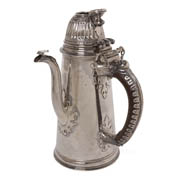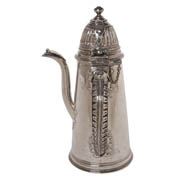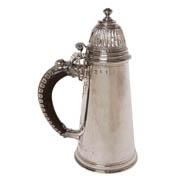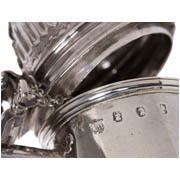Details
- Object type
pot
- Artist/Maker
- Place Associated
England, London (place of manufacture)
- Date
1702-1703, possibly, date letter blurred
- Materials
silver, wood
- Dimensions
overall: 236 mm x 154 mm x 132 mm 723 g
- Description
-
This early eighteenth-century silver chocolate pot has a cylindrical tapering body, slender spout and hinged domed fluted lid. The final of the lid is also hinged to opening to create a gap at the top of the li (for insertion of stirring stick). The wooden handle is set at right angle to the spout and mounted with silver. Both the handle and spout are decorated with leaf-shaped cut-card work where both meet the body of the pot. The pot is marks with Britannia standard, lion’s head erased, London date letter (partially obscured) probably for 1702-3, and maker’s mark ‘Lu’ over pellet for London silversmith, William Lukin.
Hot chocolate was a popular beverage during the seventeenth and eighteenth centuries. The cocoa beans required to make the hot chocolate were imported to Europe from South America, finding popularity in the early seventeenth century in Spain, France, and eventually Britain. The crushed cocoa would be mixed with hot water and fragrant spices like cardamom, cinnamon, and aniseed. Some recipes encouraged the chocolate to mixed with rich alcoholic drinks such as port or red wine.
For wealthy individuals who could afford to consume this luxury commodity within their home, silver pots for the serving of hot chocolate were commissioned with distinct features to help prepare the liquid. Silver chocolate pots often designed with a handle set at a right angle to the spout, but this was a common design feature also for coffee pots of the period. The distinguishing feature of a chocolate pot is a detachable finial for the insertion of a stirring stick, known as a ‘moilnet’. The early recipes for hot chocolate created a drink of thick consistency; the stirring stick would be slipped into the small gap under the finial to whisk and froth the chocolate for drinking. This removable finial allowed for the domed lid to remained closed keeping the hot chocolate drink inside warm.
Provenance: Harman & Co., from whom purchased by William Burrell on 29 April 1925.
- Credit Line/Donor
Gifted by Sir William and Lady Burrell to the City of Glasgow, 1944
- Collection
Burrell Collection: Silverware
- ID Number
43.121
- Location
Burrell Collection







